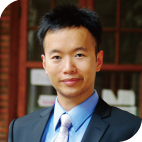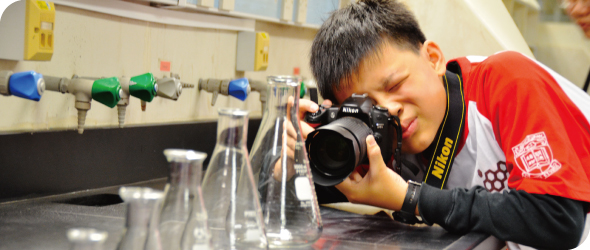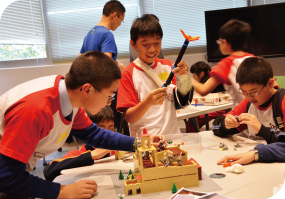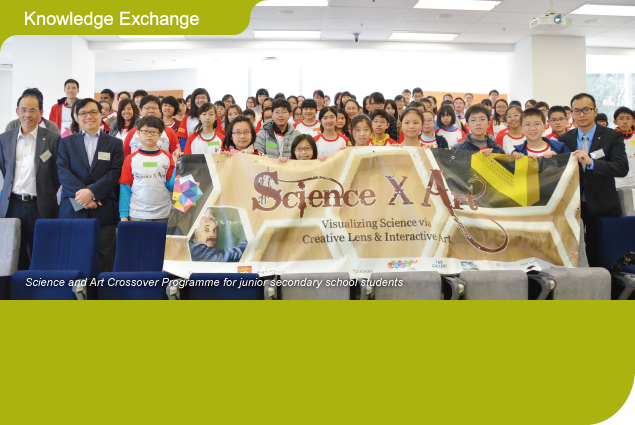As far as Dr Benny Ng Chun-hei is concerned the traditional division between Science and Art streams has always been questionable. “Science and Art are poles apart in some areas, but absolutely intertwined in many more,” he says. “They are the twin dynamics in the cultural development of civilisations. While students may want to specialise in one or the other at some stage, asking them to choose too early leads to people closing the door on vast areas of curiosity, inquiry and knowledge.”
To help open that door, Dr Ng, who is a Lecturer in the Faculty of Science, conceived the idea of a KE workshop promoting the Science and Art crossover and involving a multidisciplinary team from HKU.
Dr Ng deliberately targeted the workshops at junior secondary school students. “This is the first outreach programme aimed at forms one to three, so they’re 13 to 15 years old,” he says. “Usually, KE workshops are aimed at senior students but I wanted to target junior students because of the changes in the curriculum at secondary schools to a more holistic approach.”
A 3D drawing has elements of both science and art. That’s where we started – finding ways to visualise science artistically.
Dr Benny Ng
Visualise science artistically
He and the team set out to create workshops that would really spark the imagination by mixing the two disciplines in inspired and exciting ways. “For example, a 3D drawing has elements of both science and art,” says Dr Ng. “That’s where we started – finding ways to visualise science artistically.”
The one-day programme began with Dr Patrick Ng Tuen-wai from the Mathematics Department giving a lecture entitled ‘Geometry and Origami’, in which he demonstrated angle tri-section – one of the three classical problems of antiquity – with nary a protractor nor compass in sight.
Dr Tony Feng Shienping from the Mechanical Engineering Department explained the ‘Lotus Effect’, or why droplets of water will form a bead on the lotus plant. In ‘Science of Painting’, Professor Aleksandra B Djurišić from the Department of Physics showed how chemical compositions of paint evolved and how optics such as reflection and refraction effect the depth of an image.
Talks were followed by a choice of four hands-on workshops. ‘Capture the Moment in Laboratory’, led by Kevin Lau from the Journalism and Media Studies Centre, demonstrated basic photography techniques and then took participants on a laboratory tour to apply the techniques they had just learned.
Mr Cheung Pak-leong, a postgraduate student from the Department of Mathematics, showed how to make Platonic Solids and Archimedean Solids using coloured plastic sheets, and how to use coloured thread to create geometric patterns including curves from straight lines.
‘Painting on Canvas’, led by Dr Tsing Nam-kiu, from the Department of Mathematics, and Mike Chan, an HKU alumnus, gave participants a choice of painting one of two subjects, either a famous scientist or a scientific phenomenon, thereby giving them the chance to learn about the scientists and their work.
 Students acquire basic photography techniques in the ‘Capture the Moment in Laboratory’ workshop
Students acquire basic photography techniques in the ‘Capture the Moment in Laboratory’ workshop
Escher in 3D
 By applying mathematical and architectural theories, participants reconstruct paintings by renowned Dutch artist MC Escher and turn them 3D with LEGO®.
By applying mathematical and architectural theories, participants reconstruct paintings by renowned Dutch artist MC Escher and turn them 3D with LEGO®.
Possibly the most intriguing workshop was ‘Create the Impossibility by LEGO® – Learn Escher, Go On!’, in which students produced 3D reconstructions of the famously impossible pictures of Dutch painter MC Escher using LEGO®. His works, such as Belvedere and Relativity, apply many mathematical elements including impossible construction symmetry, and explore infinity and architecture.
“The LEGO® idea came from my colleague Dr Rachel Lui,” says Dr Ng. “She wondered if we could do something with Escher’s works. At first we were going to get participants to paint them, but then we had the idea of constructing them. A LEGO®-selling company came on board as sponsors and experts from the company helped the students make the models.”
The one-day programme was followed by an exhibition in the Learning Commons, and feedback from HKU students and staff was excellent. The exhibition has since moved to different secondary schools and residential clubs around Hong Kong.
Feedback from student participants and their teachers has also been overwhelmingly enthusiastic – and Dr Ng has applied for KE funding again next year to continue the workshops, and to introduce new ideas and exercises. “Although the KE Office does not usually fund the same project in two consecutive years, I am thrilled that it recognises the values and impacts created by this project and supports it again next year. Still, I am worried that I cannot make it a sustainable programme unless I can secure external funding,” he says.
“Next year I want to include a short movie-making section – again using the Escher models, but having LEGO® men walking up and down, filmed in stop-start motion,” he says. “I would also like to do a cooking and science workshop, a sort of MasterChef meets Master Scientist. The theme could be, say, antioxidants. You give a lecture on antioxidants first, then participants are challenged to cook something picking out the antioxidant ingredients from a choice of many.”
And for maximum excitement he envisages “a kind of chemical magic show, complete with explosions on stage.” Says Dr Ng: “If you can show people that science is fun, you can spark their interest in investigating it further. And that includes so-called ‘Arts’ people… the option should not be Science or Art, it should be Science and Art.”
For more information about the Science and Art Crossover project, including registration and donations for next year, please visit http://scixart.science.hku.hk/■


